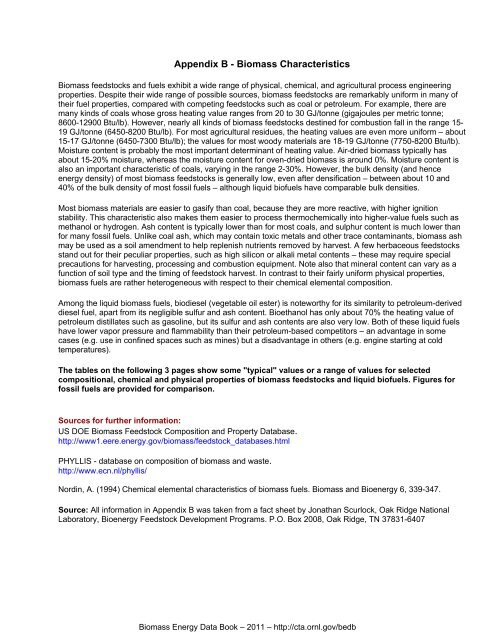Biomass Energy Data Book: Edition 4 - Full Document - Center for ...
Biomass Energy Data Book: Edition 4 - Full Document - Center for ...
Biomass Energy Data Book: Edition 4 - Full Document - Center for ...
Create successful ePaper yourself
Turn your PDF publications into a flip-book with our unique Google optimized e-Paper software.
Appendix B - <strong>Biomass</strong> Characteristics<br />
<strong>Biomass</strong> feedstocks and fuels exhibit a wide range of physical, chemical, and agricultural process engineering<br />
properties. Despite their wide range of possible sources, biomass feedstocks are remarkably uni<strong>for</strong>m in many of<br />
their fuel properties, compared with competing feedstocks such as coal or petroleum. For example, there are<br />
many kinds of coals whose gross heating value ranges from 20 to 30 GJ/tonne (gigajoules per metric tonne;<br />
8600-12900 Btu/lb). However, nearly all kinds of biomass feedstocks destined <strong>for</strong> combustion fall in the range 15-<br />
19 GJ/tonne (6450-8200 Btu/lb). For most agricultural residues, the heating values are even more uni<strong>for</strong>m – about<br />
15-17 GJ/tonne (6450-7300 Btu/lb); the values <strong>for</strong> most woody materials are 18-19 GJ/tonne (7750-8200 Btu/lb).<br />
Moisture content is probably the most important determinant of heating value. Air-dried biomass typically has<br />
about 15-20% moisture, whereas the moisture content <strong>for</strong> oven-dried biomass is around 0%. Moisture content is<br />
also an important characteristic of coals, varying in the range 2-30%. However, the bulk density (and hence<br />
energy density) of most biomass feedstocks is generally low, even after densification – between about 10 and<br />
40% of the bulk density of most fossil fuels – although liquid biofuels have comparable bulk densities.<br />
Most biomass materials are easier to gasify than coal, because they are more reactive, with higher ignition<br />
stability. This characteristic also makes them easier to process thermochemically into higher-value fuels such as<br />
methanol or hydrogen. Ash content is typically lower than <strong>for</strong> most coals, and sulphur content is much lower than<br />
<strong>for</strong> many fossil fuels. Unlike coal ash, which may contain toxic metals and other trace contaminants, biomass ash<br />
may be used as a soil amendment to help replenish nutrients removed by harvest. A few herbaceous feedstocks<br />
stand out <strong>for</strong> their peculiar properties, such as high silicon or alkali metal contents – these may require special<br />
precautions <strong>for</strong> harvesting, processing and combustion equipment. Note also that mineral content can vary as a<br />
function of soil type and the timing of feedstock harvest. In contrast to their fairly uni<strong>for</strong>m physical properties,<br />
biomass fuels are rather heterogeneous with respect to their chemical elemental composition.<br />
Among the liquid biomass fuels, biodiesel (vegetable oil ester) is noteworthy <strong>for</strong> its similarity to petroleum-derived<br />
diesel fuel, apart from its negligible sulfur and ash content. Bioethanol has only about 70% the heating value of<br />
petroleum distillates such as gasoline, but its sulfur and ash contents are also very low. Both of these liquid fuels<br />
have lower vapor pressure and flammability than their petroleum-based competitors – an advantage in some<br />
cases (e.g. use in confined spaces such as mines) but a disadvantage in others (e.g. engine starting at cold<br />
temperatures).<br />
The tables on the following 3 pages show some "typical" values or a range of values <strong>for</strong> selected<br />
compositional, chemical and physical properties of biomass feedstocks and liquid biofuels. Figures <strong>for</strong><br />
fossil fuels are provided <strong>for</strong> comparison.<br />
Sources <strong>for</strong> further in<strong>for</strong>mation:<br />
US DOE <strong>Biomass</strong> Feedstock Composition and Property <strong>Data</strong>base.<br />
http://www1.eere.energy.gov/biomass/feedstock_databases.html<br />
PHYLLIS - database on composition of biomass and waste.<br />
http://www.ecn.nl/phyllis/<br />
Nordin, A. (1994) Chemical elemental characteristics of biomass fuels. <strong>Biomass</strong> and Bioenergy 6, 339-347.<br />
Source: All in<strong>for</strong>mation in Appendix B was taken from a fact sheet by Jonathan Scurlock, Oak Ridge National<br />
Laboratory, Bioenergy Feedstock Development Programs. P.O. Box 2008, Oak Ridge, TN 37831-6407<br />
<strong>Biomass</strong> <strong>Energy</strong> <strong>Data</strong> <strong>Book</strong> – 2011 – http://cta.ornl.gov/bedb
















